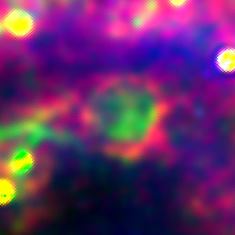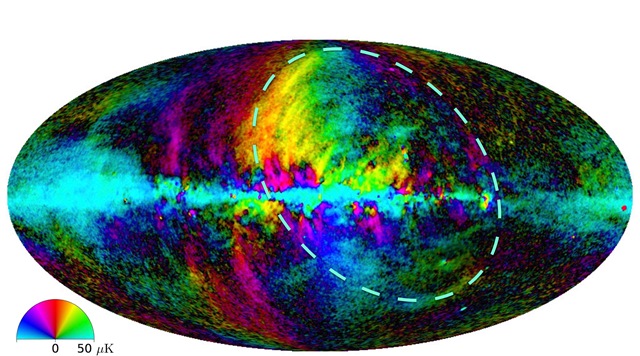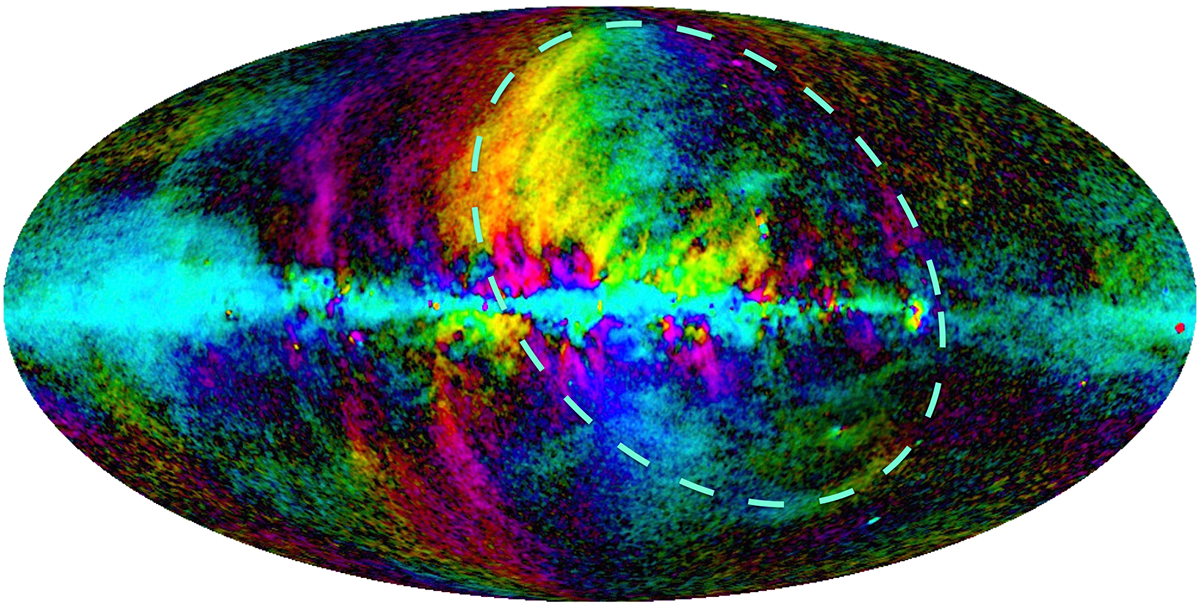| Basic Information | |
| What is this? | A map showing the direction of the Galactic magnetic field seen by Planck |
| Where is it in the sky? | The image shows the whole sky, with the larger loop spanning a third of it |
| How big is it? | The largest, most obvious loop is thought to be at lady 200 light years across |
| How far away is it? | The distance to the loop is unknown, but likely to be at least several hundred of light years |
| What do the colours represent? | The colours represent the direction of polarisation of the light, and so the magnetic field direction |

A ring of dust 200 light years across and a loop covering a third of the sky: two of the results in a new map from the Planck satellite. Dr Mike Peel and Dr Paddy Leahy of the Jodrell Bank Centre for Astrophysics (JCBA) presented the images today at the National Astronomy Meeting (NAM 2015) at Venue Cymru, Llandudno, Wales.
The European Space Agency (ESA) Planck satellite, launched in 2009 to study the ancient light of the Big Bang, has also given us maps of our own Galaxy, the Milky Way, in microwaves (radiation at cm- to mm-wavelengths). Microwaves are generated by electrons spiralling in the Galaxy’s magnetic field at nearly the speed of light (the synchrotron process); by collisions in interstellar plasma, by thermal vibration of interstellar dust grains, and by “anomalous” microwave emission (AME), which may be from spinning dust grains.
The relative strength of these processes changes with wavelength, and are separated using multi-wavelength measurements from Planck, from NASA’s WMAP satellite, and from ground-based radio telescopes, giving maps of each component.
The new maps show regions covering huge areas of our sky that produce AME; this process, only discovered in 1997, could account for a large amount of galactic microwave emission with a wavelength near 1 cm. One example where it is exceptionally bright is the 200 light year-wide dust ring around the Lambda Orionis nebula (the ‘head’ of the familiar Orion constellation). This is the first time the ring has been seen in this way.
A wide field map also shows synchrotron loops and spurs (where charged particles spiral around magnetic fields), including the huge Loop 1, discovered more than 50 years ago. Remarkably, astronomers are still very uncertain about its distance – it could be anywhere between 400 and 25,000 light years away – and though it covers around a third of the sky it is impossible to say exactly how big it is.
The new work has been submitted to “Planck 2015 results. XXV. Diffuse low-frequency Galactic foregrounds”, the Planck Collaboration, Astronomy and Astrophysics. See the preprint of this paper. This research was supported by an ERC Starting (Consolidator) Grant (no. 307209) and STFC Consolidated Grant (no. ST/L000768/1).

